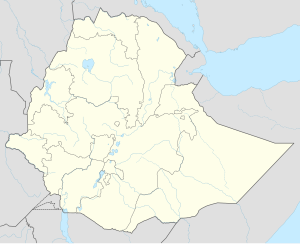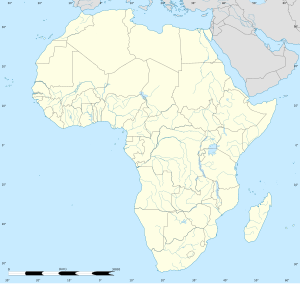Bako, Oromia
Bako
Bakkoo (Oromo) | |
|---|---|
Town | |
| Coordinates: 9°08′N 37°03′E / 9.133°N 37.050°E | |
| Country | |
| Region | |
| Zone | West Shewa Zone |
| Woreda | Bako Tibe |
| Population (2005) | |
| • Total | 18,641 |
| Time zone | UTC+3 (EAT) |
Bako is a town in central Ethiopia. Located in the West Shewa Zone of the Oromia, on the all-weather highway between Addis Ababa (Finfinne) and Naqamte, this town has a longitude and latitude of 9°08′N 37°03′E / 9.133°N 37.050°E with an elevation of 1,743 metres or 5,719 feet above sea level. Bako is the administrative center of Bako Tibe Aanaa.
During the Italian occupation, Bako is mentioned as having a medical clinic and a school. In 1948, Swedish missionaries opened a medical clinic in the town, which evolved into a mission station by 1953. By 1967, the town had phone service, as well as a primary and junior secondary schools; there was also a school for the blind, which had been moved from Addis Ababa to Bako 1961.[1] The Ethiopian Institute of Agricultural Research opened a center in Bako in 1968, which is the national center for improving the yield of maize.[2]
Based on figures from the Central Statistical Agency in 2005, Bako has an estimated total population of 18,641 of whom 9,370 are men and 9,271 women.[3] The 1994 census reported this town had a total population of 10,422 of whom 5,082 were men and 5,340 women. It is the largest of three towns in Bako Tibe.
Climate[edit]
Bako has a warm subtropical highland climate (Köppen Cwb) with a short dry season in December and January and a lengthy though not intense wet season covering the remaining ten months of the year.
| Month | Jan | Feb | Mar | Apr | May | Jun | Jul | Aug | Sep | Oct | Nov | Dec | Year |
|---|---|---|---|---|---|---|---|---|---|---|---|---|---|
| Mean daily maximum °C (°F) | 22.2 (72.0) |
25.3 (77.5) |
22.4 (72.3) |
22.1 (71.8) |
21.6 (70.9) |
20.5 (68.9) |
19.9 (67.8) |
19.9 (67.8) |
21.1 (70.0) |
21.5 (70.7) |
22.3 (72.1) |
22.7 (72.9) |
21.8 (71.2) |
| Daily mean °C (°F) | 16.4 (61.5) |
18.1 (64.6) |
17.2 (63.0) |
17.0 (62.6) |
16.8 (62.2) |
15.7 (60.3) |
15.2 (59.4) |
15.2 (59.4) |
15.9 (60.6) |
16.3 (61.3) |
16.5 (61.7) |
16.6 (61.9) |
16.4 (61.5) |
| Mean daily minimum °C (°F) | 10.6 (51.1) |
10.4 (50.7) |
11.9 (53.4) |
11.9 (53.4) |
11.9 (53.4) |
10.9 (51.6) |
10.4 (50.7) |
10.4 (50.7) |
10.7 (51.3) |
11.0 (51.8) |
10.7 (51.3) |
10.4 (50.7) |
10.9 (51.6) |
| Average rainfall mm (inches) | 16 (0.6) |
79 (3.1) |
138 (5.4) |
195 (7.7) |
98 (3.9) |
151 (5.9) |
141 (5.6) |
149 (5.9) |
129 (5.1) |
119 (4.7) |
122 (4.8) |
43 (1.7) |
1,381 (54.4) |
| Source: [4] | |||||||||||||
Notes[edit]
- ^ "Local History in Ethiopia" Archived 2008-04-08 at the Wayback Machine The Nordic Africa Institute website (accessed 2 March 2009)
- ^ EARI list of research centers Archived 2009-04-23 at the Wayback Machine (accessed 30 April 2009)
- ^ CSA 2005 National Statistics Archived 2008-11-18 at the Wayback Machine, Table B.4
- ^ Butzer, Karl W. (1971). Recent history of an Ethiopian delta: the Omo River and the level of Lake Rudolf. University of Chicago Press. pp. 24, 29.


